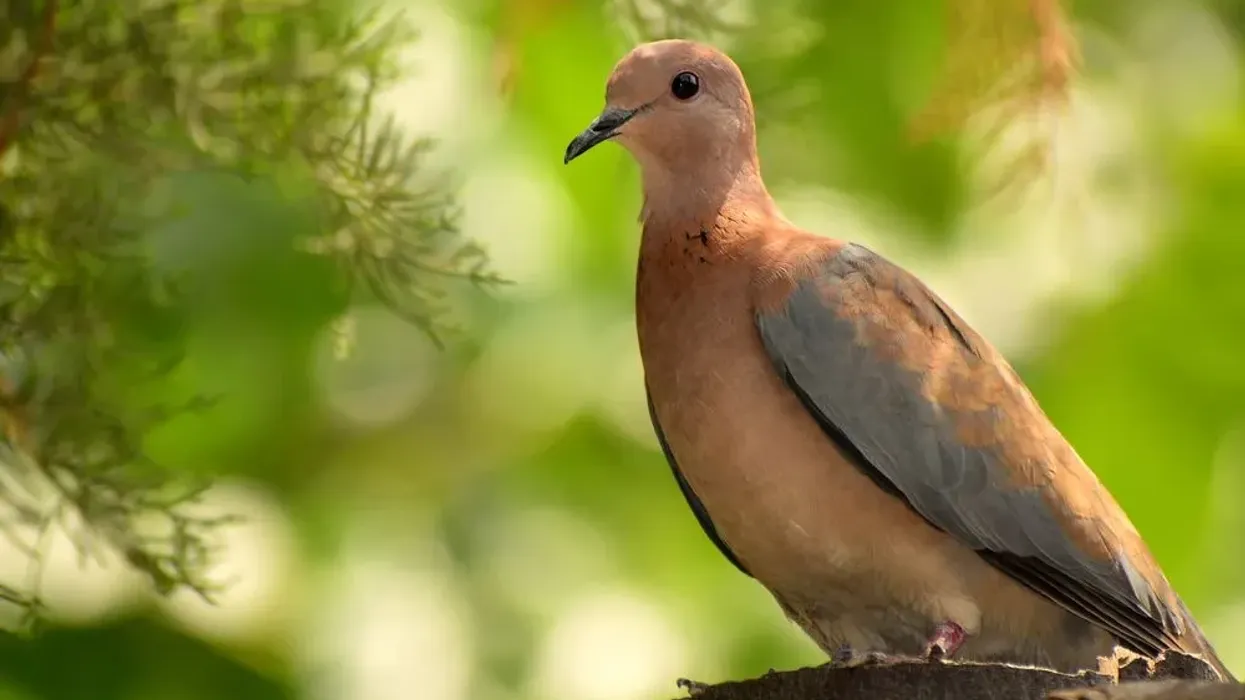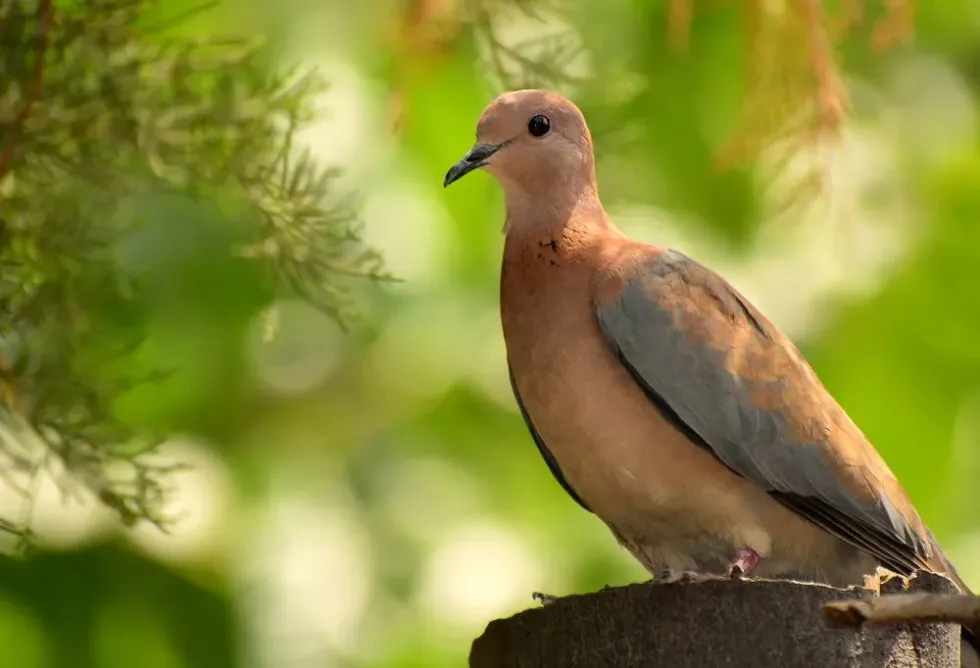The mourning dove (Zenaida macroura) is a dove of the Columbidae family. It is also known as the American mourning dove, rain dove, and turtle dove.
Historically, this bird was known as the Carolina pigeon and Carolina turtledove. It is one of the most numerous, elegant, and common birds throughout North America.
This is one of the most common species, found from southern Canada to Central Mexico, and is often plentiful in the open country land. Regardless, mourning doves have been the most hunted bird in North America, according to many reports.
Mourning doves rest on telephone wires and fodder seeds on the ground. Their gentle, stretched-out mournful coo is a very familiar sound and resembles that of laments.
Their wings make a sharp whistling or squealing sound as they take flight. If you enjoyed our article on the mourning dove, we are sure you would enjoy reading about the fruit dove.
If you liked reading this, check out these rock dove facts and eared dove facts for more.
Brown Dove Interesting Facts
What type of animal is a brown dove?
The mourning dove (Zenaida macroura) is a bird that belongs to the order Columbidae, which is a family that includes pigeons and doves.
What class of animal does a brown dove belong to?
Mourning doves are North American birds that belong to the class of Aves.
How many brown doves are there in the world?
The population reports made available on these birds are by Partners In Flight. The global breeding population is 120 million, with 81 percent spending part of the year in the United States, 19 percent in Mexico, and 5 percent in Canada. Some sources claim the population even to be as numerous as 475 million.
Where does a brown dove live?
The mourning dove can be found in a wide range of open and semi-open ground. The dove mourning tends to live in towns, villages, prairies, grasslands, and woody places. They can also survive on the desert ground.
What is a brown dove's habitat?
This North American species habitat ranges from the Greater Antilles, much of Mexico, the continental regions of the United States to the southern portions of Canada, and the Atlantic regions, including Bermuda.
Who do brown doves live with?
The mourning doves do not form groups or pairs. These birds form a pair for mating, nesting, and producing young ones in a litter of two nestlings during their breeding season. However, you will see them occasionally hanging out in groups of around five.
How long does a brown dove live?
According to the most trusted sources, the adult mourning doves survive in the wild for around two years. However, in some circumstances, their life expectancy has been recorded as high as ten years. Some anecdotal sources even claim the longest living mourning bird to be around 31 years of age.
How do they reproduce?
As the breeding season begins, the male starts courtship with a loud flight, accompanied by an elegant, smooth circular glide with the wings stretched out and the heads down. Following landing, the male mourning dove approaches the female with a puffed-up breast, head bouncing slightly, and noisy calls.
Breeding couples sometimes showcase preening behavior. After breeding, the male then takes the female to a wide range of possible nesting areas, from which the female selects one.
The nest is built by the female dove.
The pair incubates in shifts within the nest, with the male incubating from morning to afternoon and the female incubating the remainder of the day and at night. Mourning doves form a reliable parental pair who seldom leave their nest and young ones unattended.
After nesting, it takes about two weeks for the eggs to hatch. The newly hatched young, known as squabs, are highly altricial, helpless at hatching, and coated down.
What is their conservation status?
Because of their huge population and wide range, the mourning doves have the bird conservation status of Least Concern, which means that these birds are not in any imminent danger. Regardless, this bird is still considered a game bird. The hunters may shoot above 20 million of this game bird species, but this doesn't threaten their bird conservation status.
Brown Dove Fun Facts
What do brown doves look like?
Mourning doves are a delicate brown to black outside, with dark patches on their wings. The tail ends of these birds consist of white tips covered by black borders. Their heads are very small, and they look very elegant.
How cute are they?
The brown dove is considered cute by many enthusiasts of birds.
How do they communicate?
These North American birds produce the classic cooing sound pattern. Mourning doves also make non-vocal sounds in flight, such as whistling and sharp flapping noises with their hands. It's unclear what these noises convey.
How big is a brown dove?
The mourning dove is a medium-sized, elegant dove with around 12 in (30.48 cm) length. The wingspan of the mourning dove is 14-18 in (35.56-45.72 cm). It is about five times larger than the smallest bird, the bee hummingbird.
How fast can a brown dove fly?
The mourning doves have long, pointed wings and pointed tails that are longer than most dove birds, allowing them to fly surprisingly fast. They've been seen flying at speeds as high as 49.7 mph (80 kph).
How much does a brown dove weigh?
Mourning doves have a weight range of 4–6 oz (113.39-170 g ).
What are the male and female names of the species?
The female mourning dove is called a hen, and the male mourning dove is called a cock.
What would you call a baby brown dove?
The young mourning doves are called squabs or squeakers.
What do they eat?
Mourning doves eat a wide variety, including seeds, cultivated grains, and even peanuts, as well as wild grasses, weeds, vegetables, and berries, which make up the majority of a mourning dove's diet. Mourning doves eat snails occasionally.
Are they dangerous?
No, these birds are not very peaceful amongst themselves as a species, but they do not threaten the human species.
Would they make a good pet?
Dove (mourning), though not the best, can be reared. Mourning doves are independent pets and don't require much contact. However, in caring for these birds, we need to provide them with a large, clean area, warm temperatures, and a good diet for their long and healthy life.
Did you know...
Mourning doves are known for their busy feeding habits, but they do not often consume the seeds they pick up. Instead, they usually keep the seeds in their crop, which is a swollen portion of their esophagus. Some sources claim that up to 17,200 bluegrass seeds are consumed in one crop as a record for this species.
Crop milk is fed to young doves first, which is a distinct feature of this genus. These birds start the process of producing this unique milk after nesting. The pair of these birds provide for their children by regurgitating crop milk (or pigeon milk).
Brown pigeons are uncommon due to the brown/red coloration being recessive. They are less common than grey pigeons, but they are not rare.
The symbolism of the brown dove
The brown dove bird has a special role in myths and legends, and its presence to a bereaved person is often interpreted as a visitation from a deceased loved one. The person in mourning perceives a letter of hope or consolation from their departed loved one.
Others assume that the weeping dove is a messenger from angels, spirit guides, or even God. Doves following you are a symbol of your purity and grace.
They are thought to be God's messengers, and their message is that no matter what happens, peace will always come. The next time you see them, keep this in mind because they are considered to bring good luck.
Comparisons with similar birds
A turtledove is a small pigeon and not an actual dove. Turtle doves are similar in size and appearance to the mourning dove, but the turtle dove has distinctive field markings. It has light cinnamon-colored wings and white and black stripes on both sides of its body, unlike the tan-brown color of the mourning dove.
Here at Kidadl, we have carefully created lots of interesting family-friendly animal facts for everyone to discover! For more relatable content, check out these tawny owl facts and king rail facts for kids.
You can even occupy yourself at home by coloring in one of our free printable brown dove coloring pages.










